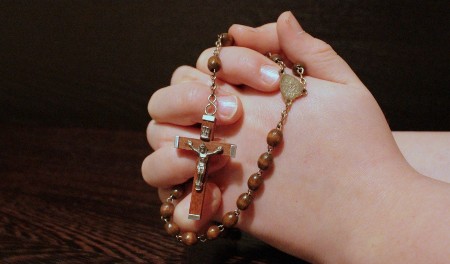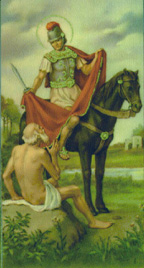We ask you, humbly: don't scroll away.
Hi readers, it seems you use Catholic Online a lot; that's great! It's a little awkward to ask, but we need your help. If you have already donated, we sincerely thank you. We're not salespeople, but we depend on donations averaging $14.76 and fewer than 1% of readers give. If you donate just $5.00, the price of your coffee, Catholic Online School could keep thriving. Thank you.Help Now >
Oscott (St. Mary's College)
FREE Catholic Classes
In 1793, a number of the Catholic nobility and gentry of England formed a committee for the establishment of a school for the education of their sons and the clergy in an English atmosphere. The buildings at Oscott, intended for the bishop's residence, were accepted for the projected institution by agreement with Bishop Thomas Talbot, Vicar Apostolic of the Midland District. Oscott (anciently Auscot) is a hamlet in the Perry Barr township, in the parish of Handsworth, about four miles north of Birmingham, and at the extreme south of Staffordshire. A mission had been founded there at the close of the seventeenth century by Andrew Bromwich, a confessor of the faith.
Dr. John Bew, sometime president of St. Gregory's College, Paris, was nominated president in February, 1794. The first three boys entered in May, and the establishment was formally opened in November as a college for boys and ecclesiastics under the joint management of a committee of laymen and the bishop of the district. Structural additions were made, and the total number of boys rose to thirty-five. The outlook was gloomy, and when in 1808, the college with its liabilities was offered to Bishop Milner , he accepted it not without reluctance. Thus ended the Old Government . The New Government , under Milner's strenuous guidance, with Thomas Potts as president (1808-15) and Thomas Walsh (afterwards bishop of the district) as spiritual director, speedily changed the aspect of affairs. Milner invigorated the discipline, and improved the studies and liturgical observances. Important additions were made to the building, and the chapel of the Sacred Heart, the first on English soil, was opened in 1820. Francis Quick, a convert, held the office of president from 1816 to 1818. On the death of Bishop Milner in 1826, the president, Thomas Walsh (1818-1826) became Vicar Apostolic of the Midland District, and Henry Weedall became president (1824-40). Under the direction of the pious and courteous Weedall, the man who more than any other created the spirit of Oscott, the institution progressed till the buildings were no longer able to accommodate the number of pupils, Plans of a new college, on the lines of Wadham College, Oxford, were prepared by Joseph Potter, the cathedral architect of Lichfield. A rich and providential bequest, together with the gifts of the clergy and the faithful, supplied the means; and in less than three years a stately Gothic pile arose on an eminence two miles from the old college. The new edifice is situated at the extreme north of Warwickshire, some six miles from the centre of Birmingham, and was built on a piece of ground overgrown with heather and gorse at the edge of Sutton Coldfield common. The name of Oscott has been transferred to the new site, previously associated with the name of Jordan's Grave. Bishop Wiseman succeeded Weedall in 1840. His reputation as a scholar and his knowledge of men and affairs made his appointment in the early days of the Oxford Movement most opportune. During the forties and onwards, Oscott afforded the incoming clergymen from the Establishment a welcome, a home, and a place of study. In those years we meet with the names of LePage Renouf, St. George Mivart, John Brande Morris, H.E. Walker, T. Wilkinson, D.H. Haigh, C. Cholmondely, E. Estcourt, B. Smith, etc. Augustus Welby Pugin, himself a convert, taught and worked at Oscott. The saintly Passionist Father Dominic was received there when he came over from Italy to convert England in November, 1840. Father Ignatius Spencer resided and exercised a fruitful apostolate in the college from 1839 to 1846. Cardinal Newman referred gratefully to the fact that just after he had been received into the Church by Father Dominic at Littlemore, he at once found himself welcomed and housed at Oscott.oe In February, 1846, Newman and his community removed to Old Oscott at the suggestion of Bishop Wiseman. Newman called the old college Maryvale, a name which it still bears. There they remained in 1849.
Henry F.C. Logan was president from 1847 to 1848, John Moore from 1848 to 1853, and Msgr. Weedall from 1853 to 1859. The first Provincial Synod of the restored hierarchy of Westminster took place at Oscott in the summer of 1852, on which occasion Dr. Newman preached the sermon entitled The Second Spring. The second and third Provincial Synods were likewise held there in 1855 and 1859. After the presidency of George Morgan (1859-60) a distinguished period in the life of the college opened in the autumn of 1860, with the appointment of James Spencer Northcote. A scholar, a gentleman, an ideal educator, brought up amid the culture of Oxford, and since his conversion in 1846, saturated with the spirit of ancient Christian Rome, he was eminently the man for the time. he developed the scholastic work of the college, and brought it into line with the non-Catholic public schools. In 1863 Cardinal Wiseman and Msgr. Manning took part in the celebration of the silver jubilee of the new college. After Northcote's retirement in 1877 on account of ill health, John Hawksford (1877-80), Edward Acton (1880-4), and Msgr. J. H. Souter (1885-9) carried on and expanded the tradition they had inherited. But a new fashion, the memory doubtless of the Fitzgerald v. Northcote trial, and of the two outbreaks of sickness in the sixties, and the opening of the Oratory School at Edgbaston (May, 1859) under the direction of Dr. Newman, told against them. The roll of students declined steadily, and notwithstanding the enthusiastic celebration of the golden jubilee of the new college in 1888, the venerable institution was closed in July, 1889, to be opened in the September following as the ecclesiastical seminary for the Diocese of Birmingham.
The high prestige which St. Mary's College enjoyed for so long a time is due to the number of distinguished families of England, Ireland, and other countries, whose sons were educated within its walls, and to the solid piety and fine courteous tone by which Oscotians were recognised. Oscott counts among its alumni one cardinal and twenty bishops, many member of Parliament, and others distinguished in the diplomatic and military services.
In accord with the movement promoted by the early provincial synods of Westminster, Bishop Ullathorne established in 1872 the Birmingham diocesan seminary at Olton, a few miles south of Birmingham. He placed the Rev. Edward Ilsley (now bishop of the diocese ) over it as rector, while he himself personally directed its spirit. The institution flourished, though the number of students averaged but twenty. Meanwhile Oscott maintained its own school of philosophers and theologians. Oscott, like Olton, suffered from financial strain. With a bold stroke Bishop Ilsley closed Oscott as a mixed college, sold the seminary buildings and estate, and gathered all his seminarists and teaching staff into the one greater seminary of St. Mary's, Oscott. The new institution began with thirty-six students in September, 1889, under the rectorship of the bishop. Subjects from other dioceses arrived, and in a year or town a maximum of eighty-six was reached. This success, combined with the advantages of a central position, a splendid site, commodious buildings, a beautiful chapel, and a rich library, led in 1897 to a conversion of Oscott, on the urgent initiative of Cardinal Vaughan , into a central seminary for seven of the midland southern dioceses of England, with Msgr. H. Parkinson as rector. The institution did its work well and progressively until the death of Cardinal Vaughan, when a new policy of concentration of diocesan resources commended itself to the ecclesiastical authorities , and the dissolution of the central seminary followed in 1909. From that date Oscott has continued its earlier work as the diocesan seminary tough admitting, as had been its custom, subjects from other dioceses. In the Birmingham seminary the lectures in theology and philosophy have invariably been given in Latin, and the usual scholastic discussions have supplemented the lectures. The course has been gradually improved the extension of philosophy to three years, by the addition of two years of physical science in connexion with philosophy. Ascetical theology has been taught regularly since 1873. Hebrew, Greek, Elocution, the history of philosophy and of religion, and also social science take the proper places in the curriculum. "Recreative" lectures by outsiders are frequently given, and the "Exchange" lectures, delivered alternately at Stonyhurst and at Oscott by the professors of each institution, have provided fruitful opportunities of intercourse.
The interior aspect of the college is like a glimpse of the old Catholic world. The windows of the cloisters and refectory are blazoned with the armorial bearings of ancient Catholic families. The walls are adorned with 260 oil paintings of religious subjects, mainly the gift of John, sixteenth Earl of Shrewsbury. Its libraries of 30,000 volumes include the "Harvington" library, dating back to the middle of the eighteenth century, the "Marini" library, purchased in Rome for the college in 1839 at the cost of 4,000 pounds, a valuable collection of early printed books, early books on the English Martyrs, the "Kirk" collection, manuscripts and pamphlets, and the "Forbes" collection of Oriental and other memoirs, consisting in all of sixty large folio volumes. Among the numerous treasures of ecclesiastical art may be mentioned the collection of embroidery of the fifteenth, sixteenth and seventeenth centuries, the silver-gilt monstrance by an Antwerp artist of 1547, valued at 2,000 pounds, and the massive bronze lectern (early sixteenth century) from St. Peter's Louvain, which is an artistic achievement of the highest excellence.
Join the Movement
When you sign up below, you don't just join an email list - you're joining an entire movement for Free world class Catholic education.
-

-
Mysteries of the Rosary
-
St. Faustina Kowalska
-
Litany of the Blessed Virgin Mary
-
Saint of the Day for Wednesday, Oct 4th, 2023
-
Popular Saints
-
St. Francis of Assisi
-
Bible
-
Female / Women Saints
-
7 Morning Prayers you need to get your day started with God
-
Litany of the Blessed Virgin Mary
The Power of the Rosary: Why Praying the Rosary Matters for Catholics
-

Lasers Reveal Hidden Mayan City of Valeriana with 6,500 Structures in Mexico
-

Embracing Peace and Unity in a Time of Division
-
The 'Black Legend': Historian Argues Anti-Catholic Bias in Spanish Conquest Narratives
-
This Catholic Hero Who Fought Against Communism Should Be Released Immediately
Daily Catholic
 Daily Readings for Monday, November 11, 2024
Daily Readings for Monday, November 11, 2024 St. Martin of Tours: Saint of the Day for Monday, November 11, 2024
St. Martin of Tours: Saint of the Day for Monday, November 11, 2024 Prayer for Deceased Veterans: Prayer of the Day for Monday, November 11, 2024
Prayer for Deceased Veterans: Prayer of the Day for Monday, November 11, 2024- Daily Readings for Sunday, November 10, 2024
- St. Leo the Great: Saint of the Day for Sunday, November 10, 2024
- Evening Prayers: Prayer of the Day for Saturday, November 09, 2024
![]()
Copyright 2024 Catholic Online. All materials contained on this site, whether written, audible or visual are the exclusive property of Catholic Online and are protected under U.S. and International copyright laws, © Copyright 2024 Catholic Online. Any unauthorized use, without prior written consent of Catholic Online is strictly forbidden and prohibited.
Catholic Online is a Project of Your Catholic Voice Foundation, a Not-for-Profit Corporation. Your Catholic Voice Foundation has been granted a recognition of tax exemption under Section 501(c)(3) of the Internal Revenue Code. Federal Tax Identification Number: 81-0596847. Your gift is tax-deductible as allowed by law.







 Daily Readings for Monday, November 11, 2024
Daily Readings for Monday, November 11, 2024 St. Martin of Tours: Saint of the Day for Monday, November 11, 2024
St. Martin of Tours: Saint of the Day for Monday, November 11, 2024 Prayer for Deceased Veterans: Prayer of the Day for Monday, November 11, 2024
Prayer for Deceased Veterans: Prayer of the Day for Monday, November 11, 2024

